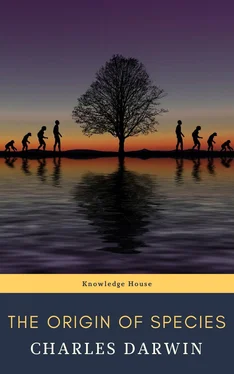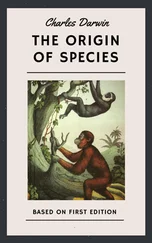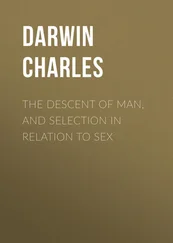Charles Darwin - The Origin Of Species
Здесь есть возможность читать онлайн «Charles Darwin - The Origin Of Species» — ознакомительный отрывок электронной книги совершенно бесплатно, а после прочтения отрывка купить полную версию. В некоторых случаях можно слушать аудио, скачать через торрент в формате fb2 и присутствует краткое содержание. Жанр: unrecognised, на английском языке. Описание произведения, (предисловие) а так же отзывы посетителей доступны на портале библиотеки ЛибКат.
- Название:The Origin Of Species
- Автор:
- Жанр:
- Год:неизвестен
- ISBN:нет данных
- Рейтинг книги:4 / 5. Голосов: 1
-
Избранное:Добавить в избранное
- Отзывы:
-
Ваша оценка:
- 80
- 1
- 2
- 3
- 4
- 5
The Origin Of Species: краткое содержание, описание и аннотация
Предлагаем к чтению аннотацию, описание, краткое содержание или предисловие (зависит от того, что написал сам автор книги «The Origin Of Species»). Если вы не нашли необходимую информацию о книге — напишите в комментариях, мы постараемся отыскать её.
Darwin had gathered much of his evidence for the book on the Beagle expedition in the 1830s to among other places the Galápagos Islands.
The Origin Of Species — читать онлайн ознакомительный отрывок
Ниже представлен текст книги, разбитый по страницам. Система сохранения места последней прочитанной страницы, позволяет с удобством читать онлайн бесплатно книгу «The Origin Of Species», без необходимости каждый раз заново искать на чём Вы остановились. Поставьте закладку, и сможете в любой момент перейти на страницу, на которой закончили чтение.
Интервал:
Закладка:
Mr. B.D. Walsh, a distinguished entomologist of the United States, has described what he calls Phytophagic varieties and Phytophagic species. Most vegetable-feeding insects live on one kind of plant or on one group of plants; some feed indiscriminately on many kinds, but do not in consequence vary. In several cases, however, insects found living on different plants, have been observed by Mr. Walsh to present in their larval or mature state, or in both states, slight, though constant differences in colour, size, or in the nature of their secretions. In some instances the males alone, in other instances, both males and females, have been observed thus to differ in a slight degree. When the differences are rather more strongly marked, and when both sexes and all ages are affected, the forms are ranked by all entomologists as good species. But no observer can determine for another, even if he can do so for himself, which of these Phytophagic forms ought to be called species and which varieties. Mr. Walsh ranks the forms which it may be supposed would freely intercross, as varieties; and those which appear to have lost this power, as species. As the differences depend on the insects having long fed on distinct plants, it cannot be expected that intermediate links connecting the several forms should now be found. The naturalist thus loses his best guide in determining whether to rank doubtful forms as varieties or species. This likewise necessarily occurs with closely allied organisms, which inhabit distinct continents or islands. When, on the other hand, an animal or plant ranges over the same continent, or inhabits many islands in the same archipelago, and presents different forms in the different areas, there is always a good chance that intermediate forms will be discovered which will link together the extreme states; and these are then degraded to the rank of varieties.
Some few naturalists maintain that animals never present varieties; but then these same naturalists rank the slightest difference as of specific value; and when the same identical form is met with in two distant countries, or in two geological formations, they believe that two distinct species are hidden under the same dress. The term species thus comes to be a mere useless abstraction, implying and assuming a separate act of creation. It is certain that many forms, considered by highly competent judges to be varieties, resemble species so completely in character that they have been thus ranked by other highly competent judges. But to discuss whether they ought to be called species or varieties, before any definition of these terms has been generally accepted, is vainly to beat the air.
Many of the cases of strongly marked varieties or doubtful species well deserve consideration; for several interesting lines of argument, from geographical distribution, analogical variation, hybridism, etc., have been brought to bear in the attempt to determine their rank; but space does not here permit me to discuss them. Close investigation, in many cases, will no doubt bring naturalists to agree how to rank doubtful forms. Yet it must be confessed that it is in the best known countries that we find the greatest number of them. I have been struck with the fact that if any animal or plant in a state of nature be highly useful to man, or from any cause closely attracts his attention, varieties of it will almost universally be found recorded. These varieties, moreover, will often be ranked by some authors as species. Look at the common oak, how closely it has been studied; yet a German author makes more than a dozen species out of forms, which are almost universally considered by other botanists to be varieties; and in this country the highest botanical authorities and practical men can be quoted to show that the sessile and pedunculated oaks are either good and distinct species or mere varieties.
I may here allude to a remarkable memoir lately published by A. de Candolle, on the oaks of the whole world. No one ever had more ample materials for the discrimination of the species, or could have worked on them with more zeal and sagacity. He first gives in detail all the many points of structure which vary in the several species, and estimates numerically the relative frequency of the variations. He specifies above a dozen characters which may be found varying even on the same branch, sometimes according to age or development, sometimes without any assignable reason. Such characters are not of course of specific value, but they are, as Asa Gray has remarked in commenting on this memoir, such as generally enter into specific definitions. De Candolle then goes on to say that he gives the rank of species to the forms that differ by characters never varying on the same tree, and never found connected by intermediate states. After this discussion, the result of so much labour, he emphatically remarks: "They are mistaken, who repeat that the greater part of our species are clearly limited, and that the doubtful species are in a feeble minority. This seemed to be true, so long as a genus was imperfectly known, and its species were founded upon a few specimens, that is to say, were provisional. Just as we come to know them better, intermediate forms flow in, and doubts as to specific limits augment." He also adds that it is the best known species which present the greatest number of spontaneous varieties and sub-varieties. Thus Quercus robur has twenty-eight varieties, all of which, excepting six, are clustered round three sub- species, namely Q. pedunculata, sessiliflora and pubescens. The forms which connect these three sub-species are comparatively rare; and, as Asa Gray again remarks, if these connecting forms which are now rare were to become totally extinct the three sub-species would hold exactly the same relation to each other as do the four or five provisionally admitted species which closely surround the typical Quercus robur. Finally, De Candolle admits that out of the 300 species, which will be enumerated in his Prodromus as belonging to the oak family, at least two-thirds are provisional species, that is, are not known strictly to fulfil the definition above given of a true species. It should be added that De Candolle no longer believes that species are immutable creations, but concludes that the derivative theory is the most natural one, "and the most accordant with the known facts in palaeontology, geographical botany and zoology, of anatomical structure and classification."
When a young naturalist commences the study of a group of organisms quite unknown to him he is at first much perplexed in determining what differences to consider as specific and what as varietal; for he knows nothing of the amount and kind of variation to which the group is subject; and this shows, at least, how very generally there is some variation. But if he confine his attention to one class within one country he will soon make up his mind how to rank most of the doubtful forms. His general tendency will be to make many species, for he will become impressed, just like the pigeon or poultry fancier before alluded to, with the amount of difference in the forms which he is continually studying; and he has little general knowledge of analogical variation in other groups and in other countries by which to correct his first impressions. As he extends the range of his observations he will meet with more cases of difficulty; for he will encounter a greater number of closely-allied forms. But if his observations be widely extended he will in the end generally be able to make up his own mind; but he will succeed in this at the expense of admitting much variation, and the truth of this admission will often be disputed by other naturalists. When he comes to study allied forms brought from countries not now continuous, in which case he cannot hope to find intermediate links, he will be compelled to trust almost entirely to analogy, and his difficulties will rise to a climax.
Читать дальшеИнтервал:
Закладка:
Похожие книги на «The Origin Of Species»
Представляем Вашему вниманию похожие книги на «The Origin Of Species» списком для выбора. Мы отобрали схожую по названию и смыслу литературу в надежде предоставить читателям больше вариантов отыскать новые, интересные, ещё непрочитанные произведения.
Обсуждение, отзывы о книге «The Origin Of Species» и просто собственные мнения читателей. Оставьте ваши комментарии, напишите, что Вы думаете о произведении, его смысле или главных героях. Укажите что конкретно понравилось, а что нет, и почему Вы так считаете.












